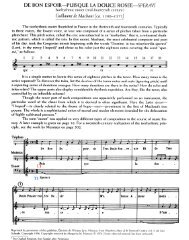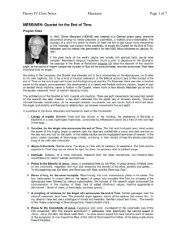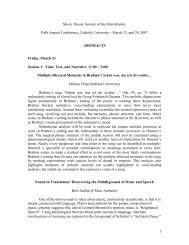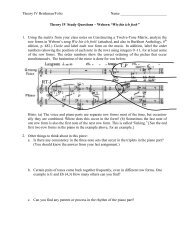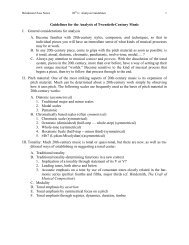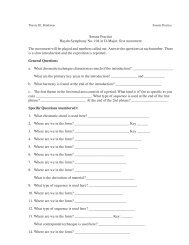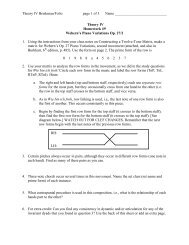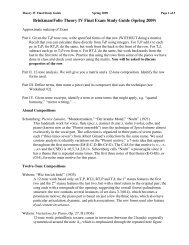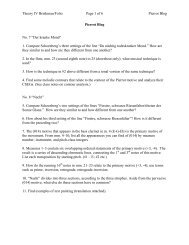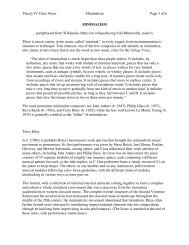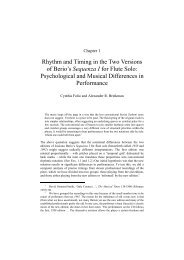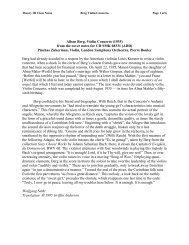Theory IV Class Notes Indeterminacy Page 1 of ... - Temple University
Theory IV Class Notes Indeterminacy Page 1 of ... - Temple University
Theory IV Class Notes Indeterminacy Page 1 of ... - Temple University
Create successful ePaper yourself
Turn your PDF publications into a flip-book with our unique Google optimized e-Paper software.
<strong>Theory</strong> <strong>IV</strong> <strong>Class</strong> <strong>Notes</strong> <strong>Indeterminacy</strong> <strong>Page</strong> 1 <strong>of</strong> 6<br />
<strong>Indeterminacy</strong>, Chance, and Aleatory Music<br />
The terms indeterminacy, chance, aleatoric, random, and improvisatory (total, controlled, or<br />
otherwise) have been applied to music in which one or more aspect <strong>of</strong> a composition are left to<br />
chance. One composer may use completely random operations, while another may use freedom<br />
in only one parameter. <strong>Indeterminacy</strong> can be partial or total, and it can affect a small part <strong>of</strong> a<br />
composition or the whole. Elements that can be “indeterminate” are pitch, note durations, form,<br />
sound material, and expression (dynamics, timbre, etc.) We will give a few examples from<br />
Reginald Smith Brindle The New Music (Oxford <strong>University</strong> Press, 1975).<br />
An early example is Morton Feldman’s Projection I for solo cello (1950). The timbre is indicated<br />
(diamond = harmonic, P = pizzicato, and A = arco) and relative pitch is shown as a square or<br />
rectangle in three relative ranges — low, medium, or high.<br />
In Stockhausen’s Zeitmasse (“tempi”), written for wind quintet in 1956, the flute and bassoon<br />
play in exact time (eighth = 112) while the oboe plays “as slow as possible”, the English horn<br />
“slow – quickening,” and the clarinet begins after a pause <strong>of</strong> imprecise duration.
<strong>Theory</strong> <strong>IV</strong> <strong>Class</strong> <strong>Notes</strong> <strong>Indeterminacy</strong> <strong>Page</strong> 2 <strong>of</strong> 6<br />
In this example from Sylvano Bussotti’s Sette Foglie (for flute and piano), the pitches are notated<br />
using traditional symbols, but in reality note-durations depend on the space occupied on the<br />
written page. This is sometimes called “proportional notation.”<br />
Berio’s Circles uses indeterminate notation to indicate rapid cascades <strong>of</strong> sounds for marimba<br />
and xylophone.
<strong>Theory</strong> <strong>IV</strong> <strong>Class</strong> <strong>Notes</strong> <strong>Indeterminacy</strong> <strong>Page</strong> 3 <strong>of</strong> 6<br />
Composers have also used “graphic scores” to suggest directions for improvisation by the<br />
performer. In these cases much <strong>of</strong> the final result is left to chance. Two examples are shown<br />
below.<br />
A large number <strong>of</strong> works are based merely on successions <strong>of</strong> sounds <strong>of</strong> imprecise duration,<br />
where instruments begin together and then play on in their own time. An example is Morton<br />
Feldman’s Durations.
<strong>Theory</strong> <strong>IV</strong> <strong>Class</strong> <strong>Notes</strong> <strong>Indeterminacy</strong> <strong>Page</strong> 4 <strong>of</strong> 6<br />
An example <strong>of</strong> indeterminate or “open” form can be found in Earle Brown’s Four Systems and<br />
various pieces in Folio (1952). The music can be played forwards or backwards, or upside down,<br />
or on designs that can be played in any position, by any number <strong>of</strong> players.<br />
Compositions heard in class.<br />
• Excerpts from Folio When the Spirit Catches You … (2003)<br />
• John Cage Aria with Fontana Mix (performance directions attached).<br />
• Excerpts from John Cage’s <strong>Indeterminacy</strong>. This consists <strong>of</strong> 90 short stories narrated by<br />
the composer and accompanied by David Tudor on synthesizer and piano. Each story is<br />
told in one minute, so the speed <strong>of</strong> delivery depends on the length <strong>of</strong> the story. The<br />
complete texts can be seen on the web site<br />
< http://www.lcdf.org/indeterminacy/index.cgi ><br />
The performance directions and first page <strong>of</strong> the score for Cage’s Aria are reproduced below.
<strong>Theory</strong> <strong>IV</strong> <strong>Class</strong> <strong>Notes</strong> <strong>Indeterminacy</strong> <strong>Page</strong> 5 <strong>of</strong> 6
<strong>Theory</strong> <strong>IV</strong> <strong>Class</strong> <strong>Notes</strong> <strong>Indeterminacy</strong> <strong>Page</strong> 6 <strong>of</strong> 6



